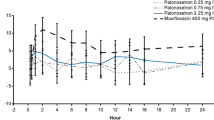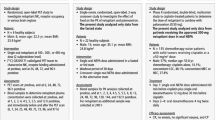Abstract
Background
The aim of this study was to estimate interindividual differences in the antiemetic effects of 5-HT3 receptor antagonists by evaluating the influence of pharmacokinetics on 5-HT3 receptor occupancies, based on receptor occupancy theory.
Methods
We analyzed interindividual differences of 5-HT3 receptor occupancies and antiemetic effects after the oral and/or intravenous administration of standard doses of the following 5-HT3 receptor antagonists: azasetron, granisetron, indisetron, ondansetron, ramosetron, and tropisetron.
Results
The interindividual difference between maximum and minimum 5-HT3 receptor occupancies after oral administration ranged from 0.6% to 64.0%, and that difference after intravenous administration ranged from 0.6% to 29.6%. Following oral administration, the interindividual difference between maximum and minimum complete vomiting inhibition rates ranged from 0.2% to 16.1%. After intravenous administration, that difference ranged from 0.8% to 52.5%.
Conclusion
Interindividual differences in the clinical effects of 5-HT3 receptor antagonists could be evaluated based on receptor occupancy theory, and the differences varied among drugs. Drug selection considering these individual variations might be useful for the patients who experienced vomiting associated with chemotherapy.
Similar content being viewed by others
References
Urushizaki I (1990) Side effects by anticancer drugs and their treatments. Jpn J Cancer Chemother 17:1959–1969
Merrifield KR, Chaffee BJ (1989) Recent advances in the management of nausea and vomiting caused by antineoplastic agents. Clin Pharm 8:187–199
Laszlo J (1983) Nausea and vomiting as major complications of cancer chemotherapy. Drugs 25(Suppl 1):1–7
Coates A, Abraham S, Kaye SB, et al. (1983) On the receiving end-patient perception of the side-effects of cancer chemotherapy. Eur J Cancer Clin Oncol 19:203–208
Joss RA, Brand BC, Buser KS, et al. (1990) The symptomatic control of cytostatic drug-induced emesis. A recent history and review. Eur J Cancer 26(Suppl 1):2–8
Sridhar KS, Donnelly E (1988) Combination antiemetics for cisplatin chemotherapy. Cancer 61:1508–1517
Andrews PLR, Rapeport WG, Sanger, GJ (1988) Neuropharmacology of emesis induced by anti-cancer therapy. Trends Pharmacol Sci 9:334–341
Mitchelson F (1992) Pharmacological agents affecting emesis. Drugs 43:295–315
Cubeddu LX, Hoffmann IS, Fuenmayor NT, et al. (1990) Efficacy of ondansetron (GR 38032F) and the role of serotonin in cisplatin-induced nausea and vomiting. N Engl J Med 322:810–816
Tortorice PV, O’Connell MB (1990) Management of chemotherapy-induced nausea and vomiting. Pharmacotherapy 10:129–145
Yamada Y, Sugiura M, Higo K, et al. (2004) Receptor occupancy theory-based analysis of antiemetic effects and standard doses of 5-HT3 receptor antagonists in cancer patients. Cancer Chemother Pharmacol 54:185–190
Carmichael J, Cantwell BM, Edwards CM, et al. (1989) A pharmacokinetic study of granisetron (BRL 43694A), a selective 5-HT3 receptor antagonist: correlation with anti-emetic response. Cancer Chemother Pharmacol 24:45–49
Interview form, azasetron hydrochloride (2000) Japan Tobacco, Tokyo
Sakamori M, Takehara S, Setoguchi M (1992) High affinity binding of Y-25130 for serotonin 3 receptor. Folia Pharmacol Jpn 100: 137–142
Interview form, indisetron hydrochloride (2005) Yakult Honsha, Tokyo
Yamada T, Tadokoro T, Nakata F, et al. (2004) Pharmacokinetics and safety of indisetron tablets in healthy subjects. Single oral dose study. Jpn Pharmacol Ther 32:807–813 (in Japanese)
Taniguchi M, Watanabe F, Hagiwara K (2004) Pharmacological characterization of indisetron hydrochloride, as a novel 5-HT3 receptor antagonist. Jpn Pharmacol Ther 32:789–797
Interview form, ondansetron hydrochloride (2005) GlaxoSmith-Kline, Tokyo
Interview form, granisetron hydrochloride (2006) Chugai Pharmaceutical, Tokyo
Haddock RE, Hidham FC, Pope JA, et al. (1990) Kinetics of granisetron hydrochloride-distribution, metabolism and excretion in rats and dogs following intravenous administration. Clin Rep 24: 6821–6843
Interview form, ramosetron hydrochloride (2006) Astellas Pharma, Tokyo
Kawabata Y, Sakiyama H, Muto S, et al. (1994) Clinical evaluation and pharmacokinetics of YM060 against the nausea and vomiting induced by anti-cancer drug-phase III clinical study. Nishinihon J Urol 56:1445–1456
Ito H, Akuzawa S, Tsutsumi R, et al. (1995) Comparative study of the affinities of the 5-HT3 receptor antagonist, YM060, YM114 (KAE-393), granisetron and ondansetron in rat vagus nerve and cerebral cortex. Neuropharmacology 34:631–637
Interview form, tropisetron hydrochloride (2005) Novartis Pharma, Tokyo
Lee CR, Plosker GL, McTavish D (1993) Tropisetron: a review of its pharmacodynamic and pharmacokinetic properties, and therapeutic potential as an antiemetic. Drugs 46:925–943
Gehlert DR, Schober DA, Gackenheimer SL, et al. (1993) Synthesis and evaluation of [125I]-(S)-iodozacopride, a high affinity radioligand for 5HT3 receptor. Neurochem Int 23:373–383
Hoshino E, Ono Y, Oshiba S, et al. (1996) Phase I study of azasetron hydrochloride (Y-25130) tablet. Single dose and multiple dose studies. J Clin Ther Med 12:2483–2501
Kumagai Y, Nakajima S, Kotegawa T, et al. (1992) Phase I study of ondansetron (the first report). Single and multiple oral dose studies in healthy male volunteers. J Clin Ther Med 8:1495–1504
Kudo S, Igarashi H, Hayami T, et al. (1996) Biological equivalence study of 2 mg and 1 mg tablets of granisetron hydrochloride. Jpn Pharmacol Ther 24:1529–1535
Nomiyama S, Tanaka T, Masuda N, et al. (1997) Phase I study of tropisetron capsules in healthy volunteers-single administration. Clin Rep 29:1523–1559
Nakajima M, Kanemaru M, Miura Y, et al. (1994) Phase I study of YM060 tablets in healthy subjects. Single intravenous dose study. Jpn J Clin Exp Med 71:2461–2468
Igarashi S, Tanaka K, Yamamura H, et al. (1992) Phase I study of Y-25130, a new 5-HT3 receptor antagonist. Single intravenous administration. Clin Rep 26:2535–2547
Kumagai Y, Nakajima S, Kotegawa T, et al. (1992) Phase I study of ondansetron (the second report). Single intraavenous dose study and continuous drip infusion dose study in healthy volunteers. J Clin Ther Med 8:1505–1513
Kumakura H, Koyanagi J, Nishioka Y, et al. (1990) Phase I study of granisetron (second report). Pharmacokinetics of granisetron following single and repeat intravenous drip infusion in Japanese healthy volunteers. J Clin Ther Med 6(Suppl 5):25–34
Nakajima M, Kanemaru M, Miura Y, et al. (1995) Phase I study of YM060 tablets. Jpn J Clin Exp Med 72:264–278
Yamada Y, Fujita M, Okuyama K, et al. (2007) Analysis of antiemetic effect of various dosage regimens of azasetron hydrochloride based on 5-HT3 receptor occupancy of serotonin. Yakugaku Zasshi 127:353–357
Author information
Authors and Affiliations
Corresponding author
About this article
Cite this article
Ayuhara, H., Takayanagi, R., Okuyama, K. et al. Receptor occupancy theory-based analysis of interindividual differences in antiemetic effects of 5-HT3 receptor antagonists. Int J Clin Oncol 14, 518–524 (2009). https://doi.org/10.1007/s10147-009-0912-5
Received:
Accepted:
Published:
Issue Date:
DOI: https://doi.org/10.1007/s10147-009-0912-5




